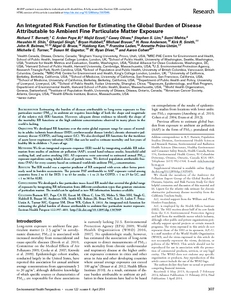Burnett, RT;
Pope, CA;
Ezzati, M;
Olives, C;
Lim, SS;
Mehta, S;
Shin, HH;
Singh, G;
Hubbell, B;
Brauer, M;
et al.
Burnett, RT; Pope, CA; Ezzati, M; Olives, C; Lim, SS; Mehta, S; Shin, HH; Singh, G; Hubbell, B; Brauer, M; Anderson, HR; Smith, KR; Balmes, JR; Bruce, NG; Kan, H; Laden, F; Prüss-Ustün, A; Turner, MC; Gapstur, SM; Diver, WR; Cohen, A
(2014)
An Integrated Risk Function for Estimating the Global Burden of Disease Attributable to Ambient Fine Particulate Matter Exposure.
ENVIRONMENTAL HEALTH PERSPECTIVES, 122 (4).
397 - 403.
ISSN 0091-6765
https://doi.org/10.1289/ehp.1307049
SGUL Authors: Anderson, Hugh Ross
![[img]](https://openaccess.sgul.ac.uk/107160/1.hassmallThumbnailVersion/ehp.1307049.pdf)  Preview |
|
["document_typename_application/pdf; charset=binary" not defined]
Published Version
Available under License St George's repository terms & conditions.
Download (532kB)
| Preview
|
Abstract
Background: Estimating the burden of disease attributable to long-term exposure to fine particulate matter (PM2.5) in ambient air requires knowledge of both the shape and magnitude of the relative risk (RR) function. However, adequate direct evidence to identify the shape of the mortality RR functions at the high ambient concentrations observed in many places in the world is lacking.
Objective: We developed RR functions over the entire global exposure range for causes of mortality in adults: ischemic heart disease (IHD), cerebrovascular disease (stroke), chronic obstructive pulmonary disease (COPD), and lung cancer (LC). We also developed RR functions for the incidence of acute lower respiratory infection (ALRI) that can be used to estimate mortality and lost-years of healthy life in children < 5 years of age.
Methods: We fit an integrated exposure–response (IER) model by integrating available RR information from studies of ambient air pollution (AAP), second hand tobacco smoke, household solid cooking fuel, and active smoking (AS). AS exposures were converted to estimated annual PM2.5 exposure equivalents using inhaled doses of particle mass. We derived population attributable fractions (PAFs) for every country based on estimated worldwide ambient PM2.5 concentrations.
Results: The IER model was a superior predictor of RR compared with seven other forms previously used in burden assessments. The percent PAF attributable to AAP exposure varied among countries from 2 to 41 for IHD, 1 to 43 for stroke, < 1 to 21 for COPD, < 1 to 25 for LC, and < 1 to 38 for ALRI.
| Item Type: |
Article
|
| Additional Information: |
Reproduced with permission from Environmental Health Perspectives |
| Keywords: |
Science & Technology, Life Sciences & Biomedicine, Environmental Sciences, Public, Environmental & Occupational Health, Toxicology, Environmental Sciences & Ecology, ENVIRONMENTAL SCIENCES, PUBLIC, ENVIRONMENTAL & OCCUPATIONAL HEALTH, SCI, LONG-TERM EXPOSURE, AIR-POLLUTION, CARDIOVASCULAR-DISEASE, LUNG-CANCER, MORTALITY, 11 Medical And Health Sciences, ASSOCIATION, 05 Environmental Sciences |
| SGUL Research Institute / Research Centre: |
Academic Structure > Population Health Research Institute (INPH) |
| Journal or Publication Title: |
ENVIRONMENTAL HEALTH PERSPECTIVES |
| ISSN: |
0091-6765 |
| Related URLs: |
|
| Dates: |
| Date | Event |
|---|
| 1 April 2014 | Published |
|
| Web of Science ID: |
WOS:000334069100024 |
| URI: |
https://openaccess.sgul.ac.uk/id/eprint/107160 |
| Publisher's version: |
https://doi.org/10.1289/ehp.1307049 |
Statistics
Item downloaded times since 12 Sep 2014.
Actions (login required)
 |
Edit Item |


